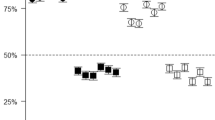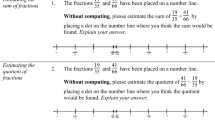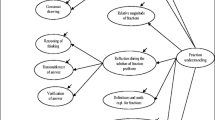Abstract
In prior work, we fit the mixture Rasch model to item responses from a fractions survey administered to a nationwide sample of middle grades mathematics teachers in the United States. The mixture Rasch model located teachers on a continuous, unidimensional scale and fit best with 3 latent classes. We used item response data to generate initial interpretations of the reasoning characteristic of each latent class. Our results suggested increasing facility reasoning about fraction arithmetic from one class to the next. The present study contributes two further arguments for the validity of our initial interpretations. First, we administered the same survey to a new sample of future middle grades mathematics teachers before and after 20 weeks of instruction on multiplication, division, and fractions, and we found that from pretest to posttest future teachers transitioned from one latent class to another in ways consistent with increased proficiency in fraction arithmetic. Second, we interviewed 8 of the future teachers before and after the instruction and found that future teachers’ reasoning during interviews was largely consistent with our original interpretation of the 3 latent classes. These results provide further support for our original interpretation of the mixture Rasch analysis, demonstrate the utility of our approach for capturing growth and change in future teachers’ reasoning during teacher education coursework, and contribute innovative applications of psychometric models for surveying teachers’ reasoning at scale.









Similar content being viewed by others
Data availability
It can be available based upon request.
Code availability
Not applicable.
Notes
We excluded Choosing a standard unit from alternate choices in the present study. Because only one item measures this characteristic on the survey, we allocated more interview time to other major characteristics that distinguish the latent classes based on our interpretation.
References
American Educational Research Association, American Psychological Association, & National Council on Measurement in Education. (1999). Standards for educational and psychological testing. American Educational Research Association.
American Educational Research Association, American Psychological Association, & National Council on Measurement in Education. (2014). Standards for educational and psychological testing. Author.
Armstrong, B., & Bezuk, N. (1995). Multiplication and division of fractions: The search for meaning. In J. T. Sowder & B. P. Schapelle (Eds.), Providing a foundation for teaching mathematics in the middle grades (pp. 85–119). State University of New York Press.
Ball, D. L., Lubienski, S., & Mewborn, D. (2001). Research on teaching mathematics: The unsolved problem of teachers’ mathematical knowledge. In V. Richardson (Ed.), Handbook of research on teaching (4th ed., pp. 433–456). American Educational Research Association.
Ball, D. L., Thames, M. H., & Phelps, G. (2008). Content knowledge for teaching: What makes it special? Journal of Teacher Education, 59(5), 389–407. https://doi.org/10.1177/0022487108324554
Beckmann, S., & Izsák, A. (2015). Two perspectives on proportional relationships: Extending complementary origins of multiplication in terms of quantities. Journal for Research in Mathematics Education, 46(1), 17–38.
Begle, E. (1979). Critical variables in mathematics education: Findings from a survey of the empirical literature. The Mathematical Association of America and the National Council of Teachers of Mathematics.
Bolt, D. M., Cohen, A. S., & Wollack, J. A. (2001). A mixture item response for multiple-choice data. Journal of Educational and Behavioral Statistics, 26, 381–409.
Boyce, S., & Norton, A. (2016). Co-construction of fractions schemes and units coordinating structures. The Journal of Mathematical Behavior, 41, 10–25.
Bradshaw, L., Izsák, A., Templin, J., & Jacobson, E. (2014). Diagnosing teachers’ understandings of rational number: Building a multidimensional test within the diagnostic classification framework. Educational Measurement: Issues and Practice, 33(1), 2–14. https://doi.org/10.1111/emip.12020.
Fischbein, E., Deri, M., Nello, M. S., & Marino, M. S. (1985). The role of implicit models in solving verbal problems in multiplication and division. Journal for Research in Mathematics Education, 16(1), 3–17.
Graeber, A. O., & Tirosh, D. (1988). Multiplication and division involving decimals: Preservice elementary teachers’ performance and beliefs. Journal of Mathematical Behavior, 7(3), 263–280.
Gwet, K. L. (2014). Handbook of inter-rater reliability: The definitive guide to measuring the extent of agreement among raters. Advanced Analytics, LLC.
Hackenberg, A. J. (2010). Students’ reasoning with reversible multiplicative relationships. Cognition and Instruction, 28(4), 383–432.
Hall, R. (2000). Videorecording as theory. In A. Kelly & R. Lesh (Eds.), Handbook of research design in mathematics and science education. Erlbaum.
Hill, H. C. (2007). Mathematical knowledge of middle school teachers: Implications for the No Child Left Behind policy initiative. Educational Evaluation and Policy Analysis, 29, 95–114.
Hill, H. C., Sleep, L., Lewis, J. M., & Ball, D. L. (2007). Assessing teachers’ mathematical knowledge: What knowledge matters and what evidence counts? In F. K. Lester (Ed.), Second handbook of research on mathematics teaching and learning (pp. 111–155). Information Age.
Inhelder, B., & Piaget, J. (1958). The growth of logical thinking from childhood to adolescence (A. Parsons & S. Milgram, Trans., 5th ed.). Basic Books.
Izsák, A. (2008). Mathematical knowledge for teaching fraction multiplication. Cognition and Instruction, 26, 95–143.
Izsák, A., Beckmann, S., & Kulow, T. (2018). Uncommon partitions: Partitioning as a problem-solving activity. Mathematics Teaching in the Middle School, 24(3), 164–171.
Izsák, A., Jacobson, E., de Araujo, Z., & Orrill, C. H. (2012). Measuring mathematical knowledge for teaching fractions with drawn quantities. Journal for Research in Mathematics Education, 43(4), 391–427.
Izsák, A., Jacobson, E., & Bradshaw, L. (2019). Surveying middle grades teachers’ reasoning about fraction arithmetic in terms of measured quantities. Journal for Research in Mathematics Education, 50(2), 156–209. https://doi.org/10.5951/jresematheduc.50.2.0156.
Izsák, A., Orrill, C. H., Cohen, A. S., & Brown, R. E. (2010). Measuring middle grades teachers’ understanding of rational numbers with the mixture Rasch model. The Elementary School Journal, 110, 279–300.
Jansen, A., & Hohensee, C. (2016). Examining and elaborating upon the nature of elementary prospective teachers’ conceptions of partitive division with fractions. Journal of Mathematics Teacher Education, 19(6), 503–522. https://doi.org/10.1007/s10857-015-9312-0
Kane, M. T. (2013). Validating the interpretations and uses of test scores. Journal of Educational Measurement, 50(1), 1–73.
Lo, J.-J., & Luo, F. (2012). Prospective elementary teachers’ knowledge of fraction division. Journal of Mathematics Teacher Education, 15(6), 481–500. https://doi.org/10.1007/s10857-012-9221-4
Lovin, L. H., Stevens, A. L., Siegfried, J., Wilkins, J. L. M., & Norton, A. (2018). Pre-K-8 prospective teachers’ understanding of fractions: An extension of fractions schemes and operations search. Journal of Mathematics Teacher Education, 21, 207–235.
Luo, F., Lo, J.-J., & Leu, Y.-C. (2011). Fundamental fraction knowledge of preservice elementary teachers: A cross-national study in the United States and Taiwan. School Science and Mathematics, 111(4), 164–177.
McAllister, C. J., & Beaver, C. (2012). Identification of error types in preservice teachers’ attempt to create fraction story problems for specified operations. School Science and Mathematics, 112(2), 88–98.
Monk, D. (1994). Subject area preparation of secondary mathematics and science teachers and student achievement. Economics of Education Review, 13(2), 125–145.
National Council of Teachers of Mathematics. (2000). Principles and standards for school mathematics. Reston, VA: Author.
National Governors Association Center for Best Practices (NGA) & Council of Chief State School Officers (CCSSO). (2010). Common core state standards for mathematics. Retrieved from http://www.corestandards.org/assets/CCSSI_Math%20Standards.pdf
Newton, K. J. (2008). An extensive analysis of preservice elementary teachers’ knowledge of fractions. American Educational Research Journal, 45(4), 1080–1110.
Ӧlmez, İ. B. (2019). Using a mixture Item Response Theory model to investigate middle grades mathematics teachers’ reasoning about fractions. Unpublished Dissertation, University of Georgia, Athens, GA.
Ӧlmez, İ. B., & Izsák, A. (2021). Characterizing reasoning about fraction arithmetic of middle grades teachers in three latent classes. Mathematical Thinking and Learning, 23(3), 225–253. https://doi.org/10.1080/10986065.2020.1780368
Philipp, R. A., & Hawthorne, C. (2015). Unpacking the referent units in fraction operations. Teaching Children Mathematics, 22(4), 240–247.
Rowan, B., Chiang, F. S., & Miller, R. J. (1997). Using research on employees’ performance to study the effects of teachers on student achievement. Sociology of Education, 70, 256–284.
Saderholm, J., Ronau, R., & Brown, E. T. (2010). Validation of the Diagnostic Teacher Assessment of Mathematics and Science (DTAMS) Instrument. School Science and Mathematics, 110, 180–191.
Senk, S. (2010). Using psychometrics to advance assessment in mathematics education. The knowing mathematics for teaching algebra (KAT) project. Paper presented at the Research Presession of the Annual Meeting of the National Council of Teachers of Mathematics, San Diego, CA.
Shechtman, N., Roschelle, J., Haertel, G., & Knudsen, J. (2010). Investigating links form teacher knowledge, to classroom practice, to student learning in the instructional system of the middle-school mathematics classroom. Cognition and Instruction, 28(3), 317–359. https://doi.org/10.1080/07370008.2010.487961
Shulman, L. S. (1986). Those who understand: Knowledge growth in teaching. Educational Researcher, 15(2), 4–14. https://doi.org/10.3102/0013189X015002004
Siegler, R. S., & Lortie-Forgues, H. (2015). Conceptual knowledge of fraction arithmetic. Journal of Educational Psychology, 107(3), 909–918.
Steffe, L. (2003). Fractional commensurate, composition, and adding schemes learning trajectories of Jason and Laura: Grade 5. Journal of Mathematical Behavior, 22, 237–295.
Toluk-Uçar, Z. (2009). Developing pre-service teachers understanding of fractions through problem posing. Teaching and Teacher Education, 25(1), 166–175.
Utley, J., & Reeder, S. (2012). Prospective elementary teachers’ development of fraction number sense. Investigations in Mathematics Learning, 5(2), 1–13.
Webel, C., Krupa, E., & McManus, J. (2016). Using representations of fraction multiplication. Teaching Children Mathematics, 22(6), 366–373.
Acknowledgements
This study was part of the first author’s dissertation. We wish to thank committee members Allan S. Cohen and Sybilla Beckmann for advice they provided throughout the study.
Funding
The development of the Diagnosing Teacher’s Multiplicative Reasoning (DTMR) Fractions survey was supported by the National Science Foundation under Grant No. DRL-0903411. The opinions expressed are those of the authors and do not necessarily reflect the views of NSF.
Author information
Authors and Affiliations
Corresponding author
Ethics declarations
Conflict of interest
The authors declared no potential conflicts of interest or competing interests with respect to the research, authorship, and/or publication of this article.
Ethics approval
The authors confirmed that all original research procedures were consistent with the principles of the research ethics published by the American Psychological Association.
Additional information
Publisher's Note
Springer Nature remains neutral with regard to jurisdictional claims in published maps and institutional affiliations.
Appendix
Appendix
See Table 8.
Rights and permissions
Springer Nature or its licensor (e.g. a society or other partner) holds exclusive rights to this article under a publishing agreement with the author(s) or other rightsholder(s); author self-archiving of the accepted manuscript version of this article is solely governed by the terms of such publishing agreement and applicable law.
About this article
Cite this article
Ölmez, İ.B., Izsák, A. Validating psychometric classification of teachers’ fraction arithmetic reasoning. J Math Teacher Educ 27, 257–289 (2024). https://doi.org/10.1007/s10857-022-09564-1
Accepted:
Published:
Issue Date:
DOI: https://doi.org/10.1007/s10857-022-09564-1




